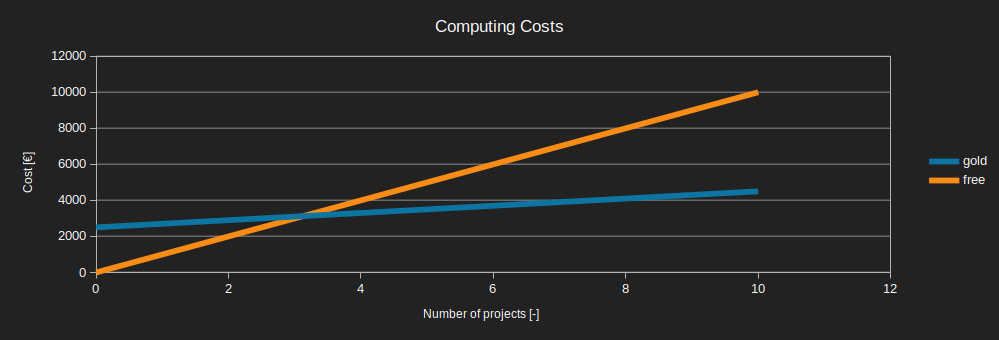ZephyCoins [Zc] are the internal currency used by ZephyScience to charge software users for their usage of cloud computing power. Accounts are debited on a pay-as-you-go basis, as a function of core-hours used for computations.
At the start of each run in the Cloud, the user can choose his machine and cluster configuration. More cores per processors imply higher costs per unit time, but also (in general) faster computations. Therefore the correlation between number of cores and final cost is not linear.
ZephyCoins are bought online on the user’s ZephyCloud account. Each ZephyCoin costs 4€, yet the equivalent computing resource provided by each ZephyCoin differs depending on the type of account:
Next picture shows how cloud consumption cost typically behaves for the two types of users. On this figure, an average cost of 200€ per project is considered.
 Gold account very quickly becomes financially worthwhile for CFD users.
Gold account very quickly becomes financially worthwhile for CFD users.
But the question remains: how much can I expect to spend on each project?
To start with, it is important to understand that exact predictions are very hard to set up in advance and require large amounts of data. Considering the amount of variables involved in each calculation, calculation times (in core-hours) can vary greatly depending on the chosen setup.
For this reason, ZephyTOOLS offers the possibility to use inbuilt default parameters which adapt to your input site to optimise calculation times.
Calculation time is mainly influenced by the mesh size and the solver robustness. Following properties must be considered:
Results from previous projects show that the ZIX value has a major influence on the project cost, while mesh size on its own is not enough to determine the computational resources needed.
A few of our projects done in the past are outlined below, to give an sense of scale for the cloud computation costs.
* 1Zc = 4€
| PROJECT | Diameter [km] | Ncells F / C [106] / [106] | Ndir F / C [-] / [-] | ZIX ⇒ Solver [-] ⇒ [-] | Ncores F / C [-] | Longest Duration [h]:[min] | Cost [Zc*] |
|---|---|---|---|---|---|---|---|
| Creyap Onshore Part 2 | 3.8 | 2.2 / 6.6 | 25 / 28 | 1 ⇒ normal | 4 / 16 | 3:12 / 3:21 | 17.0 |
ZephyTOOLS version 19.11 costs
As all directions are run simultaneously in the Cloud, the total run time corresponds to the calculation time of the longest direction.
The Creyap and Anonymous01 sites, which have very similar inputs but use different machines, show different costs but are in the same order of magnitude. This confirms that only ballpark figures can be provided and that no exact correlation can be established.
For the Rödeser Berg site (as for Creyap and Anonymous01), there were 52 directions simulated in total. This is considerably higher than typical practice in industry and explains the higher price, but ZephyScience believes it is important to consider a finer direction resolution, especially for complex sites.
Finally, the Anonymous02 site reminds us of the importance of terrain complexity on the computational resources needed. Although it has roughly half the amount of directions calculated compared to the other sites, it still remains considerably more expensive.
As a final reminder, these prices were obtained using ZephyTOOLS version 19.11.
Prices are expected to decrease with later versions as improvements are made to the software.
Prices are expected to decrease with later versions as improvements are made to the software.
